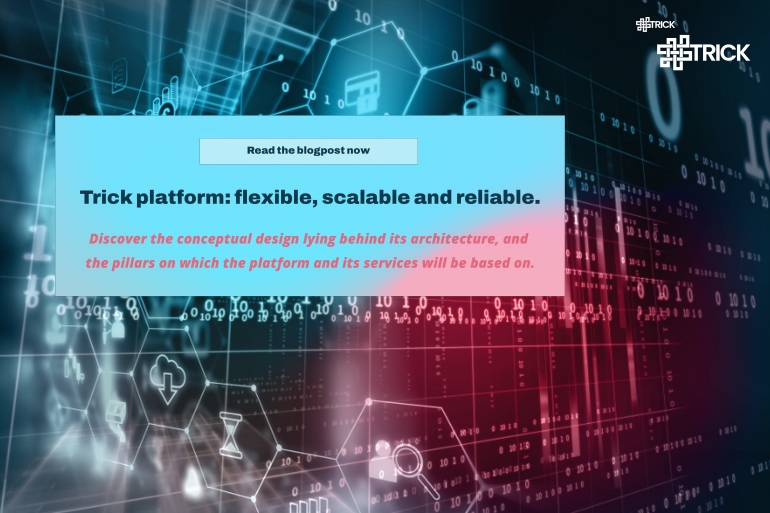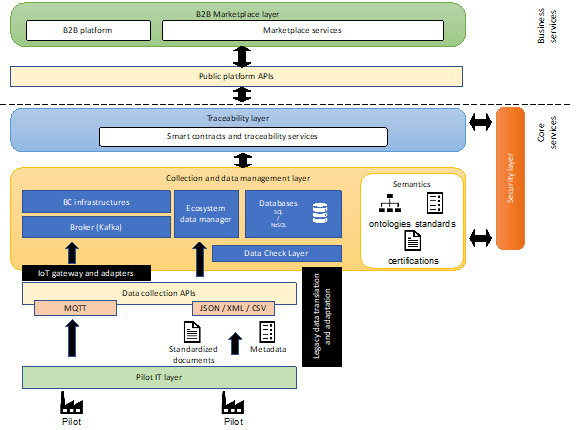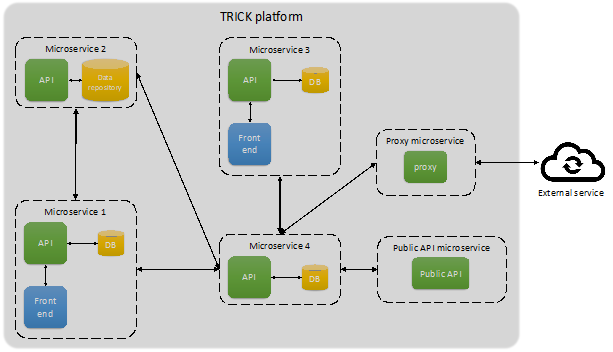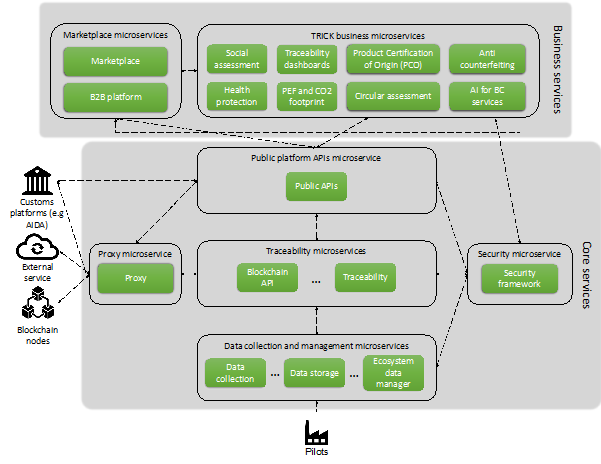Trick platform: flexible, scalable and reliable. Discover the conceptual design lying behind its architecture, and the pillars on which the platform and its services will be based on.

Image Credits: Sqetch
TRICK’s main goal is to provide affordable and standardized enablers to move SMEs closer to a circular economy. The achievement of this objective will come through the creation of a platform for the management of circular product information based on data collection and secured by Blockchain. As well-known, TRICK activities are supported by two pilots, involving Textile Clothing and Food supply chains. Therefore, the platform development is a key point of the project, and it must be managed very carefully. The first step is to determine which canons the architecture of the platform will be based on. We can define this activity as the conceptual design of the architecture; it has been faced in T2.1 and documented in D2.1 TRICK platform architecture, led by Domina, in its role of Technical Responsible.
TRICK platform, aims, and requirement
The TRICK platform will perform the collection and data management of secure product data all along the supply chain together with a set of six services available in an open B2B marketplace. Accordingly, the first logical step in architectural design consists of taking note of the end-users requirements, which have been defined in the project’s first work package (WP1). The results of the work package were endorsed by a deep analysis of the current situation, existing solutions, and user needs of the TC and Food industry in the EU to move towards a circular economy. The recommendations outlined in the work package are fundamental to address the accurate development of the TRICK platform, and the related topics can be organized as the following:
- Data model and use cases requirements, by referring to the six business services of TRICK
- Data collection requirements e.g interfaces to collect data from end-users, management and APIs, integration with existing ERP and MES systems, and data validation
- Flexibility, scalability, high availability, and performance requirements
- Security and privacy requirements, features related to the concepts of security and privacy by design approaches that will support the development of the TRICK platform.
Architecture design and concepts
The architecture of the platform builds on the collected requirements matched with TRICK’s logical sequence studied in the presentation phase of the project, which was structured on three layers: Collection and data management, Traceability, and B2B Marketplace. Starting from this assumption, the logical architecture has been organized into two concepts: the first one is related to the type of services, and the second concerns an extension of the type of layers.
The type of services is divided into Core, that is the basic blocks that provide the fundamental functionality (e.g. data collection and data management, security management and enforcement, blockchain, traceability, APIs - public platform APIs and data collection APIs), and Business services, namely the functionalities built upon core services and offered to B2B party or end-users (the marketplace services: Social assessment, Health protection, traceability dashboard PEF, PCO, circular assessment, traceability dashboards, anti-counterfeiting, AI for blockchain, B2B platform).
As for the layers they can be identified in 5 different types:
End-user IT layer: composed of the set of services, hardware equipment, types of machinery that support the manufacturing process, the execution of end-user software (e.g. ERP, MES), and data management (e.g. BOM, invoices, advice). This layer is not managed by the TRICK platform but will integrate TRICK technologies.
Collection and data management: the set of services to collect and manage data coming from end-users. A set of data collection APIs is offered to gather data from end-users using different technologies, e.g. IoT, RESTful, and legacy APIs.
Traceability: the set of components and services to implement the product traceability that is the core functionality to build the other services (e.g. PCO). In particular, the basic component is a set of smart contracts to define the operations on information. Besides this component, a set of services to manage blockchains (public and private), interoperability, and AI service are provided.

TRICK General Logic Architecture
Image Credits: DOMINA
Security: the component that implements functionalities to enforce security policies, manage privacy, confidentiality, and access control for information, services (including blockchain), devices, and users. The provided architecture follows the security-by-design approach, therefore, the security is a central component designed according to the functional and non-functional requirements of the project.
B2B marketplace: the container for business services (social assessment, health protection, PEF, PCO, circular assessment, traceability dashboards, anti-counterfeiting, AI for blockchain, B2B platform). This layer directly interacts with Public platform APIs (by using the RESTful approach) which exposes the functionalities offered by core services.
The microservices approach and architecture: application to the TRICK platform and Business services
Development and deployment of the TRICK platform will adopt the microservices approach, useful to simplify the management of an architecture based on several services, as usually happens for modern IT platforms. With microservices, it is possible to set clear boundaries among services and to define all the logic directly on each business service. Each microservice could have different components and it will provide specific functionality to the entire platform. A specific microservice is devoted to providing communications from internal services to the external world. Following this approach, the architecture allows access to external platform services by using a microservice as a Policy Enforcement Point (PEP) to enforce filtering security policy. The approach also gives flexibility and extensibility to the general TRICK architecture in order to simplify the introduction of additional services in the future. The same asset will be implemented for the Blockchain services too.
 Microservices General Architecture
Microservices General Architecture
Image Credits: DOMINA
TRICK microservice architecture merges the logical aspects with a microservices approach. Let’s investigate the flow: data coming from end-users is collected and managed by a set of microservices (e.g. Data collection, Data storage, and Ecosystem data manager), then, Traceability microservices are responsible to manage data stored in the Blockchain, to select which set of data must be stored and to implement the traceability functionality. The basic functionalities provided by Core services are exposed by Public platform APIs microservice. This service is the touchpoint among the core services, the marketplace, the business services, and the B2B platform.
In the proposed approach, each business service is a microservice, therefore, it contains the components (e.g. API, frontend, database), the logic to implement the function, and it can also access external services by using Proxy microservice, for example, to interact with external platforms.
The six business services offered by TRICK (Social assessment, Health protection assessment, Traceability dashboards, and PCO Product Certification of Origin, PEF and CO2 footprint, Circular assessment, Anti-counterfeiting, and AI for Blockchain) will be downloadable by a specific application, e.g. marketplace. By following the same approach, marketplace microservices contain this application and the B2B platform. In particular, the goal of the B2B platform is to offer access directly to the TRICK public APIs to build external applications based on TRICK services. This makes it possible for an external company to register on the TRICK platform and exploit TRICK services to build a new application or service.
 TRICK Microservices Architecture
TRICK Microservices Architecture
Image Credits: DOMINA
Protocols and standards adopted for the TRICK platform
The definition of the architecture design also provides a set of standards and protocols to be adopted, they can be summarized into three main categories: specific certificates for business services, standards to be used in the Textile Clothing and Food sector based on the state of the art of the existing semantic and transactional standards, communications protocols and standards are to be used in both Core and Business services.
Communication with other platforms: AIDA use-case
With reference to the integration with external systems, Task 2.1 defined the pillars to integrate TRICK with Italian customs. The technological environment of reference for this analysis is AIDA, the Italian customs information system. Starting from the general architecture and the description of the subsystems, on which the functional adaptations necessary for the TRICK project will have to be carried out, an approach to the interaction of AIDA with the external world, and TRICK, in particular, has been defined. The method takes into account a set of standards, already used by our partner Agenzia Dogane e Monopoli, and the interoperability models based on web services, which regulate the communication between ADM and the public/ private sector systems.
CONTACT PERSON & EMAIL ADDRESS:
- Stefano Fasana (email)
LINKS: